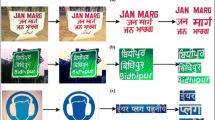Abstract
A methodology to segment the Devanagari words, extracted from the scene images, into characters is presented. Scene images include street signs, shop names, product advertisements, posters on streets, etc. Such words are prone to multiple sources of noise and these make the segmentation very challenging. The problem gets more complicated while developing the text recognition methodologies for different scripts because there is no general solution to this problem and recognizing text in some scripts can be tougher than in others. An indigenous database is created for this purpose. It consists of 130 samples, manually extracted from 200 natural scene images. The results obtained by applying the proposed techniques are encouraging. The average performance is found to be 55.77 %. The execution time for a typical word of size 1169 × 353 is found to be 4.76 s. The database and the results can serve as baseline for the future researchers.
Similar content being viewed by others
References
Liang J., Doermann D., Huiping L.: Camera-based analysis of text and documents: a survey. Int. J. Doc. Anal. Recognit. (ICDAR) Seoul, Korea 7(2), 84–104 (2005)
http://robustreading.opendfki.de/wiki/SceneText#EvaluationSoftware
Bhattacharya, U., Parui, S.K., Mondal, S.: Devanagari and Bangla text extraction from natural scene images. In: International Conference on Document Analysis and Recognition (ICDAR) Beijing, China, pp. 171–175 (2009)
Ghoshal, R., Roy, A., Bhowmik T.P., Parui, S.K.: Headline based text extraction from outdoor images. In: LNCS 6744, pp. 446–451 (2011)
Gopalan C., Manjula D.: Statistical modeling for the detection, localization and extraction of text from heterogeneous textual images using combined feature scheme. Signal Image Video Process. 5(2), 165–183 (2011)
Ramana Murthy O.V., Roy S., Narang V., Hanmandlu M.: Devanagari character recognition in the wild. Int. J. Comput. Appl. 38(4), 38–45 (2012)
Kompalli, S., Setlur, S.: Design and comparison of segmentation driven and recognition driven Devanagari OCR. In: Proceedings of the Second International Conference on Document Image Analysis for Libraries (DIAL) Lyon, France, pp. 96–102 (2006)
Kompalli, S., Nayak, S., Setlur, S., Govindaraju, V.: Challenges in OCR of Devanagari documents. In: International Conference on Document Analysis and Recognition (ICDAR), Seoul, Korea, pp. 327–331 (2005)
Garain U., Chaudhuri B.: Segmentation of touching characters in printed Devanagari and Bangla scripts using fuzzy multifactorial analysis. IEEE Trans. Syst. Man Cybern. Part C 32(4), 449–459 (2002)
Bansal V., Sinha R.: Segmentation of touching and fused Devanagari characters. Pattern Recogn. 35(4), 875–893 (2002)
Bansal V., Sinha R.M.K.: Integrating knowledge resources in Devanagari text recognition system. IEEE Trans. Syst. Man Cybern. Part C 30(4), 500–505 (2000)
Junejo, I.N., Bhutta, A.A., Foroosh, H.: Single-class SVM for dynamic scene modeling. Signal Image Video Process. doi:10.1007/s11760-011-0230-z (in press)
de Campos, T., Babu, B., Varma, M.: Character recognition in natural images. In: International Conference on Computer Vision Theory and Applications, Lisbon, Portugal, pp. 273–280 (2009)
Fraser S., Ravanbakhsh M.: A Fast Corner Detector Based on the Chord-to-Point Distance Accumulation Technique, pp. 519–525. Digital Image Computing: Techniques and Applications (DICTA) Melbourne, Australia (2009)
Radhakrishna, A., Hemami, S., Estrada, F., Susstrunk, S.: Frequency-tuned salient region detection. In: IEEE Conference on Computer Vision and Pattern Recognition (CVPR), Miami, FL, USA, pp. 1597–1604 (2009)
Otsu N.: A threshold selection method from gray level histograms. IEEE Trans. Syst. Man Cybern. 9, 62–66 (1979)
Shahab, A., Shafait, F., Dengel, A.: ICDAR 2011 robust reading competition challenge 2: reading text in scene images. In: International Conference on Document Analysis and Recognition (ICDAR) Beijing, China, pp. 1491–1496 (2011)
Liu, H., Ding, X.: Handwritten character recognition using gradient feature and quadratic classifier with multiple discrimination schemes. In: International Conference on Document Analysis and Recognition (ICDAR) Washington, DC, USA, pp. 19–25 (2005)
Zheng, Q., Chen, K., Zhou, Y., Gu, C., Guan, H.: Text localization and recognition in complex scenes using local features. In: LNCS (Proc. ACCV 2010), vol. 6494, pp. 121–132
Wang, K., Babenko, B., Belongie, S.: End-to-end scene text recognition. In: IEEE International Conference on Computer Vision (ICCV), Barcelona, Spain (2011)
Neumann, L., Matas, J.: A method for text localization and recognition in real-world images. In: LNCS, pp. 770–783
Author information
Authors and Affiliations
Corresponding author
Rights and permissions
About this article
Cite this article
Ramana Murthy, O.V., Roy, S., Narang, V. et al. An approach to divide pre-detected Devanagari words from the scene images into characters. SIViP 7, 1071–1082 (2013). https://doi.org/10.1007/s11760-012-0345-x
Received:
Revised:
Accepted:
Published:
Issue Date:
DOI: https://doi.org/10.1007/s11760-012-0345-x




